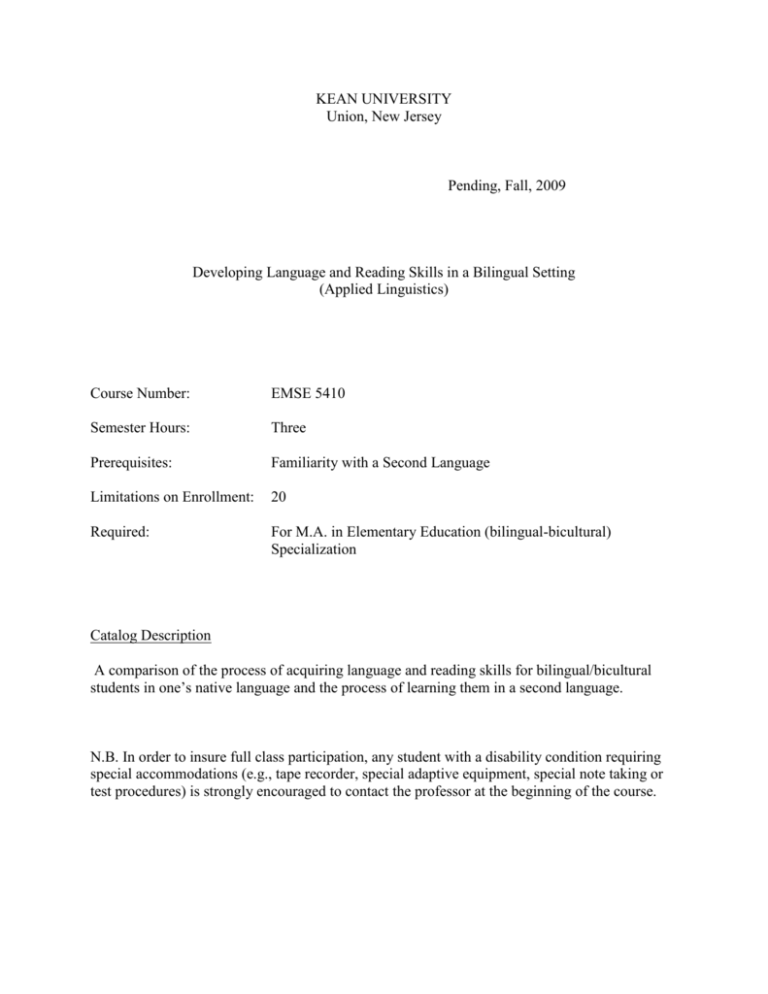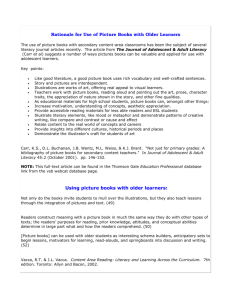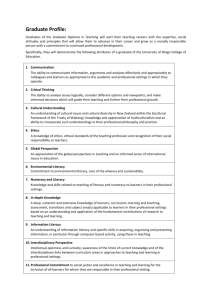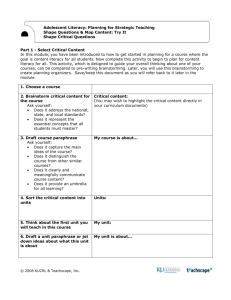EMSE 5410 - Kean University
advertisement

KEAN UNIVERSITY Union, New Jersey Pending, Fall, 2009 Developing Language and Reading Skills in a Bilingual Setting (Applied Linguistics) Course Number: EMSE 5410 Semester Hours: Three Prerequisites: Familiarity with a Second Language Limitations on Enrollment: 20 Required: For M.A. in Elementary Education (bilingual-bicultural) Specialization Catalog Description A comparison of the process of acquiring language and reading skills for bilingual/bicultural students in one’s native language and the process of learning them in a second language. N.B. In order to insure full class participation, any student with a disability condition requiring special accommodations (e.g., tape recorder, special adaptive equipment, special note taking or test procedures) is strongly encouraged to contact the professor at the beginning of the course. Kean University Union, New Jersey Developing Language and Reading Skills in A Bilingual Setting (Applied Linguistics) I. Course Objectives The goal of this course is to provide the student with a broad exposure to the research, issues and problems related to teaching content areas to second language learners by providing the opportunity to acquire knowledge (k), apply skills (s) and develop values (d). The student will: A. explain and analyze the differences between the processes of initial and second language acquisition and development. (k, s, d) B. evaluate alternative methods and techniques that will improve the bilingual/bicultural student’s reading proficiency in English and in his/her native language. (k, s, d) C. explore and develop an understanding of the process of transferring initial reading skills from the native language to reading in the second language of students. (k, s, d) D. evaluate the appropriate instructional materials and computer software in the areas of language and reading in both the English and native language of students. (k, s, d) E. analyze and evaluate the special problems involved in testing the bilingual/bicultural student’s level of proficiency and achievement in language and reading skills in both the native and English languages. (k, s, d) II. Course Content A. Discussion and analysis of first and second language acquisition and development theories 1. Language acquisition and development stages 2. Acquisition of phonology and syntax 3. Generative transformational theory 4. Cognitive code theory 5. Sentence reduction theory B. Discussion and evaluation of alternative methods and approaches to the teaching 3 of reading 1. Reading through the native language 2. Immersion approach 3. Linguistic summary approach 4. Language alternation approach 5. Consideration of pre-literate and literate students’ need C. Discussion and analysis of language transfer 1. Contrastive linguistic analysis a. False cognates b. Phonemic discrepancies c. Grammatical structures 2. Comparative linguistic analysis a. Simple sentence structure b. True cognates c. Grammatical structure D. Strategies for identifying and selecting appropriate instructional materials and computer software 1. Analysis of commercial material 2. Analysis of teacher made material 3. Practice, through unit and lesson planning, in using commercial and teacher made materials 4. Identification of computer software and practical experience with computers E. Strategies for analyzing and evaluating testing instruments 1. Analysis of oral and written tests 2. Analysis of cultural biases and/or other contaminated test items III. Methods of Instruction A. 4 Lecture, demonstrations and discussions B. C. D. E. Cooperative learning activities, class and laboratory experiences Student unit planning and presentation of sample lessons including material, methods and techniques Required reading and reports Internet research IV. Methods of Evaluation A. B. C. Written exams and other written assignments (k, s) Class participation and discussion (k, s, d) Unit plan development and presentation (k, s, d) IV. Suggested Text Brisk, M.E. & Harrington, M.M., (2007). Literacy and Bilingualism. A Handbook for ALL Teachers. Lawrence Erlbaum Associates, Mahwah, NJ V. Bibliography Books (Some of these books were recently acquired by the university library) August, D., Shanahan, T. (Eds) (2006) Developing literacy in second-language learners: Report of the national literacy panel on language minority children and youth. NY: Routledge Bennett, C. (2007) Comprehensive Multicultural Education. Theory and Practice. 6th Edition. NY: Pearson Biancarosa, G., & Snow, C. (2004). Reading Next.A Vision For Action And Research In Middle And High School Literacy - A report to Carnegie Corporation of New York. Washington: DC, Alliance for Excellent Education. Calderon, Margarita (2007) Teaching English To English Language Learners. Grades 6-12. Thousand Oaks: CA. Corwin Press Freeman, Y.S. & Freeman, D.E. (2006) Teaching Reading And Writing In Spanish And English In Bilingual And Dual Language Classrooms. Portsmouth: NH. Heinemann Genesee, F. Lindholm-Leary, Saunders, W. M. and Christian, D. (2006). Educating English Language Learners: A Synthesis Of Research Evidence Cambridge: Cambridge UP, 2006. NCELA. National Clearinghouse for English Language Acquisition . (November 2008). Dual Language Learners In The Early Years: Getting Ready To Succeed In School. NCELA, Washington D.C. 5 Ovando, C., Combs, M.C., & Collier, V.P. (2006). Bilingual & ESL Classrooms. Teaching In Multicultural Contexts. 4th Edition. NY. McGraw Hill Short, D. & Fitzsimmons, S. (2007) Double the work. A report to Carnegie corporation of New York. The Challenges And Solutions To Acquiring Language And Academic Literacy For Adolescent English Language Learners. Washington: DC, CAL Tomlinson, C.A. & McTighe, J. (2006) Integrating Differentiated Instruction plus Understanding by Design. Connecting Content and Kids. Alexandria: VA. ASCD Peer-Reviewed Articles Burgoyne, K., Kelly née Hutchinson, J., Whiteley, H., & Spooner, A.. (2009). The comprehension skills of children learning English as an additional language. British Journal of Educational Psychology, 79(4), 735 Cirino, P., Vaughn, S., Linan-Thompson, S., Cardenas-Kagan, E. Fletcher, J., & Francis, D. (2009). One-Year Follow-Up Outcomes of Spanish and English Interventions for English Language Learners at Risk for Reading Problems. American Educational Research Journal, 46(3), 744-781 Coleman, R., & Goldenberg, C. (2009). What Does Research Say about Effective Practices for ENGLISH LEARNERS? Kappa Delta Pi Record, 46(1), 10-16 Cynthia L. Uline, Megan Tschannen-Moran, & Thomas DeVere Wolsey. (2009). The walls still speak: the stories occupants tell. Journal of Educational Administration, 47(3), 400-426 DelliCarpini, M.. (2009). Success with ELLs. English Journal, 98(5), 116-119 DelliCarpini, M.. (2009). Success with ELLs. English Journal, 98(6), 100-103. Greenleaf, C., & Hinchman, K.. (2009). Reimagining Our Inexperienced Adolescent Readers: From Struggling, Striving, Marginalized, and Reluctant to Thriving. Journal of Adolescent & Adult Literacy, 53(1), 4-13 Jewell, M.. (2009). Moving Beyond Intermediate English Proficiency. Journal of Adolescent & Adult Literacy, 53(3), 259-262 Lara, L., & Moore, D.. (2009). Literacy Instruction for Adolescent English Learners: An Interview With Lorenza Lara. Journal of Adolescent & Adult Literacy, 53(2), 173-175 Larrotta, C., & Ramirez, Y.. (2009). Literacy Benefits for Latina/o Parents Engaged in a Spanish Literacy Project. Journal of Adolescent & Adult Literacy, 52(7), 621-630 Malatesha Joshi, R., Binks, E., Hougen, M., Dahlgren, M., Ocker-Dean, E., & Smith, D.. (2009). Why Elementary Teachers Might Be Inadequately Prepared to Teach Reading. Journal of 6 Learning Disabilities: Special Issue: Perceptions and Reality: What We Know About, 42(5), 392-402 Moje, E., & Luke, A.. (2009). Literacy and Identity: Examining the Metaphors in History and Contemporary Research. Reading Research Quarterly, 44(4), 415-437 Musetti, B., Salas, S., & Perez, T.. (2009). Working for and with Latino/Latina Immigrant Newcomers in the English Language Arts Classroom. English Journal, 99(2), 95-97 Musti-Rao, S., Hawkins, R., & Barkley, E.. (2009). Effects of Repeated Readings on the Oral Reading Fluency of Urban Fourth-Grade Students: Implications for Practice. Preventing School Failure, 54(1), 12-23 Ro, Y., & Cheatham, G.. (2009). Biliteracy and Bilingual Development in a Second-Generation Korean Child: A Case Study. Journal of Research in Childhood Education, 23(3), 290308 Schulz, M.. (2009). Effective Writing Assessment and Instruction for Young English Language Learners. Early Childhood Education Journal, 37(1), 57-62 Sox, A., & Rubinstein-Ávila, E.. (2009). WebQuests for English-Language Learners: Essential Elements for Design. Journal of Adolescent & Adult Literacy, 53(1), 38-48 Teale, W.. (2009). Students Learning English and Their Literacy Instruction in Urban Schools. The Reading Teacher, 62(8), 699-703 Townsend, D.. (2009). Building Academic Vocabulary in After-School Settings: Games for Growth With Middle School English-Language Learners. Journal of Adolescent & Adult Literacy, 53(3), 242-251 Young, C., & Rasinski, T.. (2009). Implementing Readers Theatre as an Approach to Classroom Fluency Instruction. The Reading Teacher, 63(1), 4-13 Zeece, P., & Wallace, B.. (2009). Books and Good Stuff: A Strategy for Building School to Home Literacy Connections. Early Childhood Education Journal, 37(1), 35-42 Seminal Works Ada, A. F. (1990). A Magical Encounter: Spanish Language Children’s Literature in the Classroom. Compton, CA: Santillana Publishing Co. Bialystok, E. (1991). Language Processing in Bilingual Children. New York: Cambridge University Press. 7 Cloud, N., Genesee, F. & Hamayan, E. (2000). Dual Language Instruction. A Handbook of Enriched Education. Boston: Heinle & Heinle Publishers. Cummins, J. (2001). Negotiating identities: Education for empowerment in a diverse society. 2nd Edition. Los Angeles: California Association for Bilingual Education Day, J., Spiegel, D. L., McLellan , J., & Brown, V. B. (2002). Moving Forward with Literature Circles. Saint Louis, MO: Scholastic. Flecther, R. & J. Portalupi. (2001). Writing Workshop. The Essential Guide. Westport, CT: Heinemann. Lavine, R. Z. (Ed) & Kassen, M. A. (Chair) (2001). Beyond the Boundaries: Changing Contexts in Language Learning. NY: McGraw Hill Moll, L.C., & Greenberg, J. (1990). Creating zones of possibilities: Combining social contexts for instruction. In L.C. Moll (Ed.), Vygotsky and education (pp. 319-348). Cambridge: Cambridge University Press. Moll, L. C., Amanti, C., Neff, D., & González, N. (1992). Funds of knowledge for teaching: Using a qualitative approach to connect homes and classrooms. Theory into Practice, 31(2), 132-141. Perez, B. & Torres-Guzman, M. (1992). Learning in Two Worlds. New York: Longman Publishing Group. Pinnell, G. S. & Fauntas, I. C. (2001). Leveled Books for Readers. Westport, CT: Heinemann. Rámirez, A. G. (1995). Creating Contexts for Second Language Acquisition. Theory and Methods. New York: Longman Publishers. Reading Panel (2000). Teaching children to read. A report of the national reading panel. Washington: National Institute of Children Health and Human Development. Journals American Education Research Journal Adolescent Literacy Journal Reading Research Quarterly Bilingual Research Journal Lectura y vida (An IRA publication for Latin America) 8







